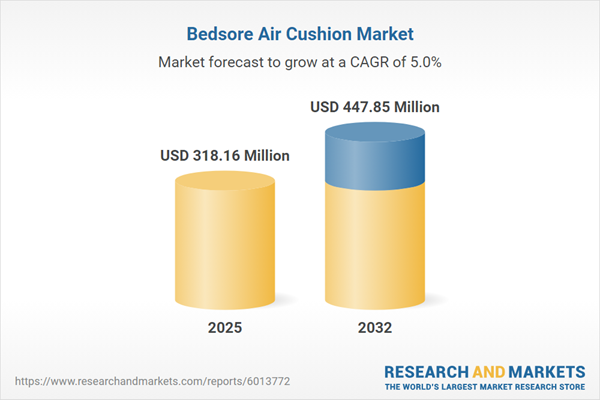Speak directly to the analyst to clarify any post sales queries you may have.
Bedsore air cushion solutions are rapidly advancing in response to evolving patient care requirements, delivering reliable pressure management and supporting improved safety outcomes across varied healthcare environments.
Market Snapshot: Growth Trajectory for Bedsore Air Cushion Market
The bedsore air cushion market grew from USD 303.76 million in 2024 to USD 318.16 million in 2025. Continuing at a compound annual growth rate of 4.97%, the market is projected to reach USD 447.85 million by 2032. This momentum reflects expanding clinical adoption, innovation in patient-centric design, and a steady focus on patient safety and operational efficiency.
Scope & Segmentation
This research report delivers comprehensive coverage of the bedsore air cushion market, breaking down critical aspects that drive business decisions:
- Product Types: Alternating pressure cushions, combination mattresses, and low air loss cushions tailored for differentiated care settings.
- Inflation Technologies: Automatic inflation systems and manual inflation options that address varying facility needs.
- Cushion Designs: Multi-chamber and single chamber cushions configured for targeted or simplified pressure relief.
- Material Types: Nylon-based, polyvinyl chloride, and thermoplastic polyurethane variants, each offering specific durability and hygiene benefits.
- Pressure Types: Dynamic air mattresses cycling pressure for active prevention and static air mattresses for consistent support.
- Distribution Channels: Pharmacies, specialty stores, and online retailers connecting facilities and home-care buyers with timely access.
- Applications: Long-term care, post-surgical recovery, rehabilitation, and use in assisted living, home care environments, hospitals, and nursing homes.
- Regional Coverage: Americas, Europe, Middle East & Africa, and Asia-Pacific, with country-level analysis for North America, Latin America, western and eastern Europe, key Middle Eastern and African nations, and Asia-Pacific economies.
- Key Industry Players: Action Products, Arjo, Blue Chip Medical Products, Drive Medical, Etac AB, Frontier Medical Group, GF Health Products, Hill-Rom Holdings by Baxter International Inc., Invacare Holdings, Joerns Healthcare, LINET Group, Medline Industries, Permobil AB, Proactive Medical Products, Stryker Corporation, Sunrise Medical, Talley Group, Wellell Inc., XIAMEN SENYANG CO,.LTD.
Bedsore Air Cushion Market: Key Takeaways
- Senior healthcare decision-makers increasingly adopt advanced air cushion solutions to improve pressure ulcer prevention and patient comfort.
- Innovations include sensor-enabled cushions and integration with digital health platforms, supporting real-time monitoring and data-driven care adjustments.
- Material advancements, such as antimicrobial fabrics and lightweight composites, help facilities reduce infection risks and streamline maintenance workflows.
- Regional market variations prompt industry participants to tailor value propositions, balancing regulatory needs with local distribution and end-user support.
- Strategic partnerships, clinical validation studies, and agile distribution networks are strengthening competitive positioning and accelerating innovation pipelines.
- With ongoing demographic shifts and evolving reimbursement practices, flexible product roadmaps are critical to meeting changing institutional and home care requirements.
Tariff Impact on Bedsore Air Cushion Market
In 2025, new United States tariffs on imported raw materials and components led to noticeable shifts in global supply chain strategies. Manufacturers expanded domestic production, adapted sourcing tactics, and worked closely with local logistics providers to control costs and mitigate disruptions. These measures encouraged broader investments in regional manufacturing while distributors and end-users focused on cost-containment, seeking purchasing frameworks that minimize volatility in institutional budgets. The industry continues to see new opportunities in response to these changes, especially for leaders agile in operational realignment.
Methodology & Data Sources
This report employs robust primary and secondary research. Peer-reviewed publications, regulatory documentation, and company filings provide the foundational data, validated through expert interviews with procurement managers, clinicians, and engineers. Quantitative findings are rigorously cross-checked via triangulation and qualitative feedback is systematically coded to reveal market drivers and technology trends. Competitive benchmarking and advanced analytical frameworks ensure reliable, actionable insights throughout the study.
Why This Report Matters for Bedsore Air Cushion Solutions
- Uncovers essential market dynamics, highlighting crucial technology and regulatory shifts for informed, high-impact decision making.
- Enables senior executives to interpret key segmentation, innovation, and supply chain factors driving global adoption.
- Delivers actionable recommendations to enhance product development, streamline procurement, and future-proof operational resilience in healthcare delivery.
Conclusion
The bedsore air cushion market is marked by steady technological advancement and renewed operational focus as the industry meets rising clinical and regulatory demands. Leaders who invest in innovation, supply chain agility, and localized strategies will be well-positioned for growth and sustained performance.
Additional Product Information:
- Purchase of this report includes 1 year online access with quarterly updates.
- This report can be updated on request. Please contact our Customer Experience team using the Ask a Question widget on our website.
Table of Contents
3. Executive Summary
4. Market Overview
7. Cumulative Impact of Artificial Intelligence 2025
Companies Mentioned
The companies profiled in this Bedsore Air Cushion market report include:- Action Products, Inc.
- Arjo
- Blue Chip Medical Products
- Drive Medical
- Etac AB
- Frontier Medical Group
- GF Health Products, Inc.
- Hill-Rom Holdings, Inc. By Baxter International Inc.
- Invacare Holdings Corporation
- Joerns Healthcare
- LINET Group
- Medline Industries, LP
- Permobil AB
- Proactive Medical Products
- Stryker Corporation
- Sunrise Medical
- Talley Group Ltd
- Wellell Inc. (formerly Apex Medical Corp.)
- XIAMEN SENYANG CO,.LTD
Table Information
| Report Attribute | Details |
|---|---|
| No. of Pages | 182 |
| Published | November 2025 |
| Forecast Period | 2025 - 2032 |
| Estimated Market Value ( USD | $ 318.16 Million |
| Forecasted Market Value ( USD | $ 447.85 Million |
| Compound Annual Growth Rate | 4.9% |
| Regions Covered | Global |
| No. of Companies Mentioned | 20 |









